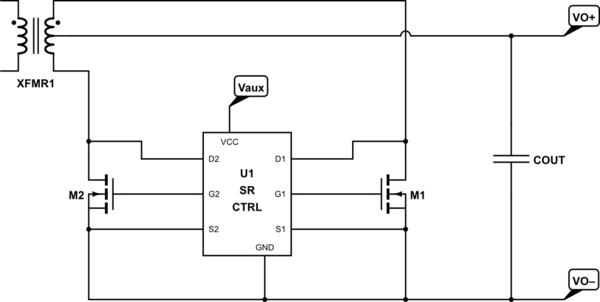Is there any application for below circuit which has a high-side N-MOSFET without a driver or charge pump?
I use a similar circuit (yes, not exactly the same circuit) as some sort of "clamper" in one of my designs: I keep the gate voltage constant and I make use of the body diode to decide when to switch on or off the MOSFET.
Below is a simplified schematic of the secondary-side sync-rectifier (SR) of the converter (a resonant converter, by the way):

simulate this circuit – Schematic created using CircuitLab
The U1, SR controller, takes D (drain) and S (source) connections of the SR MOSFETs as inputs, and outputs G (gate) voltages to drive the MOSFETs. And this particular IC uses a sophisticated method to drive the MOSFETs so it needs to measure the drain voltage when the respective MOSFET is on.
The voltages at the opposite ends of the secondary winding are out of phase and have opposite signs w.r.t. the centre-tap. So, when one winding has negative voltage the respective SR MOSFET's body diode will be in conduction, and the controller IC will catch this and turn the MOSFET on. And whilst the MOSFET is on the drain voltage will be negative. And when the winding voltage increases (rising edge) the IC will catch this as well and turn the MOSFET off.
The MOSFET with positive winding voltage should stay off but its drain stress will be more than twice the output voltage. So, for a converter with 56V output, the IC's D pins will see ~120V. But the IC allows a maximum of 100V. We can't use a simple dropper (series Zener or voltage divider) because, even though the positive voltage level is not relevant for the IC, it requires the exact negative voltage when the MOSFET is on. So I put a circuit which I'd like to name as "positive-clamper-negative-passthrough" to protect the IC:

simulate this circuit
And here's the clamper section (shown one side only, the other side has the exact same circuit):

simulate this circuit
The circuit above basically clamps the voltage seen by the IC at its D pin at around Vaux as the circuit operates as a source follower (a.k.a. common drain).
Can still be considered as a high-side MOSFET, and is not driven with bootstrapping.





